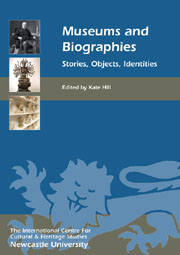Book contents
- Frontmatter
- Contents
- List of Illustrations
- Introduction: Museums and Biographies – Telling Stories about People, Things and Relationships
- INDIVIDUAL BIOGRAPHY AND MUSEUM HISTORY
- PROBLEMATISING INDIVIDUALS' BIOGRAPHIES
- 4 ‘His Best Successor’: Lady Eastlake and the National Gallery
- 5 Women, Museums and the Problem of Biography
- 6 A Curatocracy: Who and What is a V&A Curator?
- INSTITUTIONAL BIOGRAPHIES
- OBJECT BIOGRAPHIES
- MUSEUMS AS BIOGRAPHY
- MUSEUMS AS AUTOBIOGRAPHY
- Endpiece: The Homunculus and the Pantograph, or Narcissus at the Met
- List of Contributors
- Index
5 - Women, Museums and the Problem of Biography
from PROBLEMATISING INDIVIDUALS' BIOGRAPHIES
Published online by Cambridge University Press: 05 February 2013
- Frontmatter
- Contents
- List of Illustrations
- Introduction: Museums and Biographies – Telling Stories about People, Things and Relationships
- INDIVIDUAL BIOGRAPHY AND MUSEUM HISTORY
- PROBLEMATISING INDIVIDUALS' BIOGRAPHIES
- 4 ‘His Best Successor’: Lady Eastlake and the National Gallery
- 5 Women, Museums and the Problem of Biography
- 6 A Curatocracy: Who and What is a V&A Curator?
- INSTITUTIONAL BIOGRAPHIES
- OBJECT BIOGRAPHIES
- MUSEUMS AS BIOGRAPHY
- MUSEUMS AS AUTOBIOGRAPHY
- Endpiece: The Homunculus and the Pantograph, or Narcissus at the Met
- List of Contributors
- Index
Summary
In the opening pages of Biography: A Very Short Introduction, Hermione Lee describes the genre of biography through the striking metaphors of the autopsy and the portrait. A biography is like an autopsy because it literally opens up the individual to ‘investigate, understand, describe, and explain what may have seemed obscure, strange, or inexplicable’ (Lee 2009, 1). Conversely, the metaphor of the portrait suggests that biographies can capture the character of a subject, bringing a person to life through ‘attention to detail and skill in representation’ (Lee 2009, 2). Taken together, these metaphors underscore both the analytical and representational operations of biography: a genre that has the ability to look back on a life for the purposes of analysis and assessment at the same time as it seeks to render the subject as a singular entity whose life can be seized as a totality. The tension between the temporality of ‘looking back’ to chart the unfolding of a past and the seeming fixity of a life captured is another intriguing aspect of Lee's twin metaphors insofar as it highlights the narratological character of biographical writing for the purposes of constructing a unified subject. As Sharon O'Brien notes, biography is conventionally understood as ‘a linear, chronological, unified narrative [that] can present us with an essential self ’ (O'Brien 1991, 126) and as such lends itself fairly easily to uncritical accounts of individual travails and accomplishments.
- Type
- Chapter
- Information
- Museums and BiographiesStories, Objects, Identities, pp. 75 - 86Publisher: Boydell & BrewerPrint publication year: 2012



